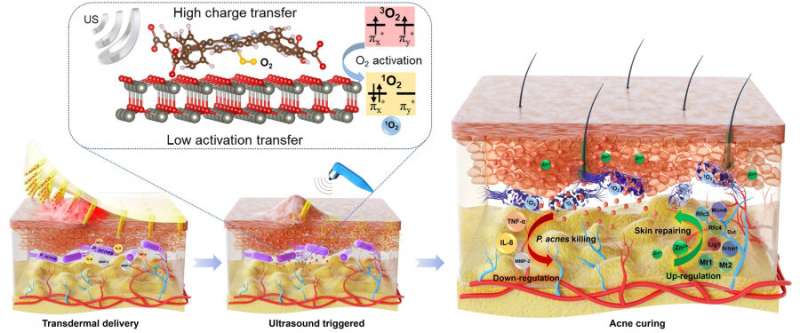This article has been reviewed according to Science X's editorial process and policies. Editors have highlighted the following attributes while ensuring the content's credibility:
fact-checked
peer-reviewed publication
trusted source
proofread
Microneedle array embedded with ultrasound-triggered antibacterial nanoparticles for acne treatment

A research team led by Professor Kelvin Yeung from the Department of Orthopedics and Traumatology, School of Clinical Medicine, LKS Faculty of Medicine, the University of Hong Kong (HKUMed) has designed a new microneedle patch to offer a highly-effective non-antibiotic approach for the treatment of skin infections.
In brief, the design engineered with ultrasound-responsive zinc-based metal-organic framework (MOF) antibacterial nanoparticles promises pain-free delivery to treat bacterial infection on skin tissue and facilitate skin repair at the same time. The novel microneedle is around 50 microns in diameter, similar to a typical hair. The findings have been published in Science Advances.
Acne is a common skin disease worldwide that affects more than 80% of teenagers and young adults. The primary cause is excessive lipid secretion that clogs the hair follicles, thereby establishing a hypoxic microenvironment in the skin tissue. This undesirable condition particularly favors the proliferation of Propionibacterium acnes (P. acnes) bacteria. Pimples, regarded as a skin infection, is mainly caused by this P. acnes bacteria that affects millions of people worldwide.
It not only causes patients significant physical and emotional distress but may also develop into a chronic inflammatory condition without proper treatment. The clinical management normally includes non-prescription treatment (i.e., benzoyl peroxide and salicylic acid), or the administration of antibiotics orally or topically. However, such treatments can be ineffective and may have unpleasant side effects.
In general, the first-line treatment for infected pimples is antibiotics administered either orally or topically. However, the therapeutic effect of topical antibiotic treatment is concerning, particularly when the drugs pass through the skin tissue. Also, the treatment becomes less effective as bacteria develop drug resistance or when they migrate to subcutaneous tissue. P. acnes bacteria can also secrete extracellular polysaccharides to form a biofilm that blocks the attacks initiated by antibacterial agents or immune cells.

Most microneedle products on the market use pharmaceutical ingredients to treat acne. However, repeated applications of antibiotics may reduce the sensitivity of the bacteria to drugs. Patients who have been affected by acne for a long time will know that the effects of the same treatment products can be significantly reduced after long-term use.
The HKUMed team has invented a new microneedle patch that facilitates the transdermal delivery of ultrasound-responsive antibacterial nanoparticles to treat the infection induced by P. acnes in a minimally invasive approach. In the current design, ultrasound-responsive antibacterial nanomaterials are introduced in the microneedle patch that responds to bacterial infection quickly and efficiently. The use of drugs is thereby avoided in the treatment of acne.
The modified nanoparticles are composed of ZnTCPP and ZnO and are able to produce a substantial amount of reactive oxygen species (ROS) subject to ultrasound stimulation that can effectively oxidize the key cellular macromolecules of bacteria. The results demonstrate that the killing of P. acnes bacteria mediated by ROS can reach 99.73% after 15 minutes of ultrasound stimulation. Also, the levels of inflammatory markers, including tumor necrosis factor-a (TNF-α), interleukins (ILs), and matrix metalloproteinases (MMPs) are significantly reduced. Furthermore, the zinc ions released can elevate the DNA replication-related genes, thereby augmenting more fibroblasts toward superior skin repair.
Professor Kelvin Yeung Wai-kwok said, "The new microneedle patch enabling ROS generation upon ultrasound stimulation, regarding as a non-antibiotic and transdermal approach, can not only effectively address the infection induced by P. acnes bacteria, but also facilitates the skin repair due to zinc ion release. Due to the specific killing mechanism of ROS, we believe that this design is also able to address the other skin infections induced by fungi, parasites, or viruses, such as tinea pedis ('Athlete's Foot' or 'Hong Kong Foot' in slang)."
More information: Yiming Xiang et al, Ultrasound-triggered interfacial engineering-based microneedle for bacterial infection acne treatment, Science Advances (2023). DOI: 10.1126/sciadv.adf0854
Journal information: Science Advances
Provided by The University of Hong Kong





















